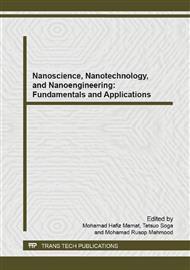[1]
M. Quintanilla-Carvajal, B. Camacho-Díaz, L. Meraz-Torres, J. Chanona-Pérez, L. Alamilla-Beltrán, A. Jimenéz-Aparicio, Nanoencapsulation: A new trend in food engineering processing, Food Engineering Reviews. 2(2010) 39–50.
DOI: 10.1007/s12393-009-9012-6
Google Scholar
[2]
H. Bouwmeester, S. Dekkers, M. Y. Noordam, W. I. Hagens, A. S. Bulder, C. D. Heer, S. E. C. G. Ten Voorde, S. W. P. Wijnhoven, H. J. P. Marvin, Review of health safety aspects of nanotechnologies in food production. Regulatory Toxicology and Pharmacology. 53 (2009) 52-62.
DOI: 10.1016/j.yrtph.2008.10.008
Google Scholar
[3]
V. J. Mohanraj, Y. Chen, Nanoparticles – A Review. Tropical Journal of Pharmaceutical Research. 5 (2006) 561-573.
Google Scholar
[4]
C. Monica, R. Cremonini, Nanoparticles and higher plants. Caryologia. 62(2009) 161-165.
DOI: 10.1080/00087114.2004.10589681
Google Scholar
[5]
M. Cushen, J. Kerryb, M. Morrisc, M. Cruz-Romerob, E. Cummins , Nanotechnologies in the food industry – Recent developments, risks and regulation, Trends in Food Science & Technology. 24 (2012) 30-46.
DOI: 10.1016/j.tifs.2011.10.006
Google Scholar
[6]
Q. Chaudhry, M. Scotter, J. Blackburn, B. Ross, A. Boxall, L. Castle, R. Aitken, R. Watkins, Review: Applications and implications of nanotechnologies for the food sector, Food Additives and Contaminants. 25 (2008) 241–258
DOI: 10.1080/02652030701744538
Google Scholar
[7]
S. S. Bhadoriya, A. Mangal, N. Madoriya, P. Dixit, Bioavailability and Bioactivity Enhancement of Heral Drugs by "Nanotechnology" : A Review, Journal of Current Pharmaceutical Research. 8 (2011) 1-7.
Google Scholar
[8]
H. D. Chen, J. C. Weiss, F. Shahidi, Nanotechnology in nutraceuticals and functional foods, Food Technology. 25 (2006) 30-36.
Google Scholar
[9]
T. Takatsuka, T. Endo, Y. Jianguo, K. Yuminoki, N. Hashimoto, Nanosizing of Poorly Water Soluble Compounds Using Rotation/Revolution Mixer, Chem. Pharm. Bull. 57 (2009)1061-1067.
DOI: 10.1248/cpb.57.1061
Google Scholar
[10]
X. Zhao, Z. Yang, G. Gai, Y. Yang, Effect of superfine grinding on properties of ginger powder, Journal of Food Engineering. 91 (2009) 217–222
DOI: 10.1016/j.jfoodeng.2008.08.024
Google Scholar
[11]
M. Z. Borhan, R. Ahmad, M. Rusop, S. Abdullah, Optimization of ball milling parameters to produce Centella asiatica herbal nanopowder, Journal of Nanostructure in Chemistry. 3 (2013) 79.
DOI: 10.1186/2193-8865-3-79
Google Scholar
[12]
J. C. Liu, Z. G. Jiao, X. H. Liang, L. Han, H. Liu, Effect of Ultrafine Pulverization on Properties of Apple Pomace Powder, Advanced Materials Research. Volx 236 – 238 (2011) 2560-2563.
DOI: 10.4028/www.scientific.net/amr.236-238.2560
Google Scholar
[13]
J. R. Liu, G. F. Chen, H. N. Shih, P. C. Kuo, Enhanced antioxidant bioactivity of Salvia miltiorrhiza (Danshen) products prepared using nanotechnology, Phytomedicine. 15 (2008) 23-30.
DOI: 10.1016/j.phymed.2007.11.012
Google Scholar
[14]
Y. I. Su, Z. Y. Fu, C. J. Quan, W. M. Wang, Fabrication of nano Rhizama Chuanxiong particles and determination of tetramethylpyrazine, Transactions of Nonferrous Metals Society of China. 16 (2006) s393-s397.
DOI: 10.1016/s1003-6326(06)60218-5
Google Scholar
[15]
J. Lee, Drug nano- and microparticles processed into solid dosage forms: physical properties, J. Pharm. Sci. 92 (2003) 2057–2068.
DOI: 10.1002/jps.10471
Google Scholar
[16]
A. Charkhi, H. Kazemian, M. Kazemeini, Optimized experimental design for natural clinoptilolite zeolite ball milling to produce nano powders, Powder Technology. 203 (2010) 389–396.
DOI: 10.1016/j.powtec.2010.05.034
Google Scholar
[17]
S. Yashvanth, S. S. Rani, A. S. Rao, S. S. Madhavendra, Microscopic and micro chemical evaluation (elemental Analysis) of the medicinal herb, Lippia nodiflora (Linn.) Rich (Phyla nodiflora Linn. Green), Asian Pacific Journal of Tropical Disease. (2012) S124-S129 .
DOI: 10.1016/s2222-1808(12)60137-6
Google Scholar


